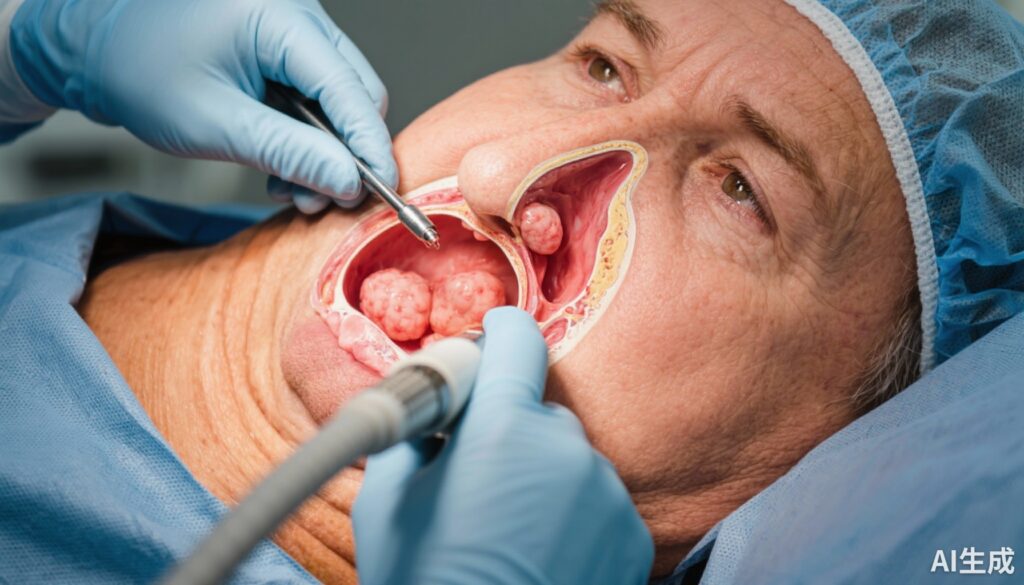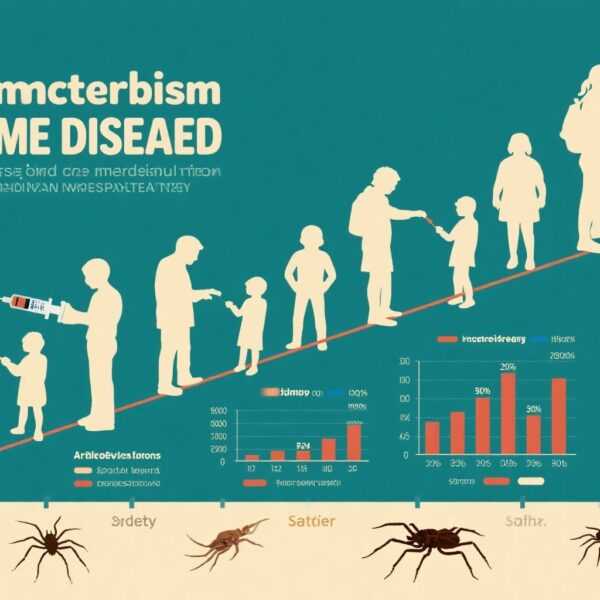Highlight
- Endoscopic sinus surgery significantly improves disease-specific quality of life at 6 months in chronic rhinosinusitis patients, outperforming clarithromycin and placebo.
- Long-term, low-dose clarithromycin treatment shows no significant benefit over placebo in symptom control or quality of life.
- The study revealed no fatal serious adverse events, confirming surgical and antibiotic treatment safety profiles.
- Intranasal corticosteroids and saline irrigation remain foundational therapies; surgery is recommended when these are insufficient.
Study Background and Disease Burden
Chronic rhinosinusitis (CRS) is a prevalent and debilitating inflammatory condition characterized by persistent sinonasal symptoms lasting at least 12 weeks. It manifests with or without nasal polyps, affecting the mucosal lining of the sinuses and nasal passages. Patients endure significant reductions in quality of life, with symptoms including nasal obstruction, facial pain, hyposmia or anosmia, and mucopurulent nasal discharge. CRS imposes substantial healthcare utilization and socioeconomic burden globally.
Treatment typically follows a stepwise approach beginning with medical therapy such as intranasal corticosteroids and saline nasal irrigation. However, when symptoms persist, adjunctive therapies such as antibiotics or endoscopic sinus surgery (ESS) are considered, though evidence guiding the choice between these remains sparse.
This paucity of robust comparative data has led to wide variations in clinical practice—up to fivefold differences in ESS rates and inconsistent antibiotic use—highlighting an unmet need for evidence-based guidance on managing refractory CRS.
Study Design
The MACRO trial was a pragmatic, multicentre, three-arm, randomised, placebo-controlled phase 4 study conducted across 20 secondary and tertiary care sites in the UK. It enrolled 514 adults (age ≥18) diagnosed with CRS who remained symptomatic despite prior appropriate medical therapy — including intranasal corticosteroids, saline nasal irrigations, and a prior short course of antibiotics.
Participants were randomly allocated (1:1:1) to one of three groups:
1. Endoscopic sinus surgery (within 6 weeks of randomisation when possible) plus standardized intranasal medication
2. Clarithromycin treatment (250 mg twice daily for 2 weeks, then 250 mg once daily for 10 weeks) plus standardized intranasal medication
3. Placebo plus standardized intranasal medication
The intranasal medication regimen included intranasal corticosteroids and saline irrigations, which all participants continued.
Randomisation was stratified by nasal polyp status and trial site, using a secure web-based automated system with permuted blocks. Participants and site teams remained blinded to the clarithromycin and placebo allocation to preserve outcome assessment objectivity, though surgery allocation was unblinded due to its nature.
The primary endpoint was disease-specific quality of life assessed by the total score on the 22-item Sino-Nasal Outcome Test (SNOT-22) at 6 months post-randomisation, analyzed on an intention-to-treat (ITT) basis.
Safety outcomes including adverse reactions and serious adverse events were monitored across groups.
Key Findings
Among 514 participants, 410 had CRS with nasal polyps, and 104 had CRS without polyps. Allocation was nearly equal: 171 to ESS, 172 to clarithromycin, and 171 to placebo, with all receiving intranasal corticosteroids and saline irrigations.
At 6 months, the mean SNOT-22 scores demonstrated clinically sizeable and statistically significant improvements in the ESS group compared to both clarithromycin and placebo groups:
– ESS vs. Clarithromycin: adjusted mean difference -18.13 (98.33% CI -24.26 to -11.99), p<0.0001
– ESS vs. Placebo: adjusted mean difference -20.44 (98.33% CI -26.42 to -14.46), p<0.0001
There was no statistically significant difference between clarithromycin and placebo groups:
– Clarithromycin vs. Placebo: adjusted mean difference -3.11 (98.33% CI -8.56 to 2.33), p=0.17
| 6-month SNOT-22 score: n; mean (SD) | Comparison* | Adjusted mean difference (98·33% CI) | p value | |
|---|---|---|---|---|
| Clarithromycin | n=160; 42·8 (26·1) | Clarithromycin vs placebo | −3·11 (−8·56 to 2·33) | 0·17 |
| Endoscopic sinus surgery | n=153; 24·3 (17·8) | Endoscopic sinus surgery vs clarithromycin | −18·13 (−24·26 to −11·99) | <0·0001 |
| Placebo | n=147; 46·8 (22·3) | Endoscopic sinus surgery vs placebo | −20·44 (−26·42 to −14·46) | <0·0001 |
This indicates that clarithromycin, despite its anti-inflammatory and antimicrobial properties, did not provide additional symptomatic benefit beyond placebo when administered as long-term low-dose therapy.
Safety outcomes were reassuring, with ten serious adverse events occurring in nine participants across all arms: two events in the clarithromycin group (1%), three in placebo (2%), and five in the ESS group (2%). There were no fatalities reported.
Secondary outcomes, including subgroup analyses by polyp status, symptom domain improvements, and patient-reported outcome measures, consistently favoured the surgical intervention over clarithromycin and placebo.
Expert Commentary
The MACRO trial rigorously addresses a critical clinical question with pragmatic trial design reflecting real-world practice. It robustly demonstrates that when standard intranasal therapies fail to control CRS symptoms, endoscopic sinus surgery offers significant symptomatic and quality-of-life benefits within six months.
Notably, the lack of efficacy for prolonged low-dose clarithromycin challenges prior practices advocating macrolides for their putative immunomodulatory effects in CRS. These findings align with emerging skepticism regarding antibiotic overuse and the need to reserve surgery for appropriately selected patients.
Some limitations include the unblinded nature of surgical allocation, inherent in surgical trials, and a relatively short primary outcome follow-up at 6 months. However, the trial’s ongoing long-term follow-up may provide insights into sustained benefits or late complications.
Overall, the results advocate for a careful reevaluation of current CRS management algorithms and reinforce the role of ESS as a definitive intervention, particularly in patients with persistent symptoms despite optimized medical management.
Conclusion
The MACRO trial provides High-quality evidence that endoscopic sinus surgery significantly improves disease-specific quality of life in adults with chronic rhinosinusitis refractory to initial medical therapy. In contrast, long-term, low-dose clarithromycin does not confer benefit beyond placebo and should not be routinely used.
Clinicians should consider ESS strongly when intranasal corticosteroids and saline irrigations fail to control symptoms, offering patients meaningful symptomatic relief and improved quality of life without increased risk.
Future research should focus on long-term surgical outcomes, biomarkers to guide personalized therapy, and optimized medical regimens that may minimize the need for surgical intervention.
References
Philpott C, Beard DJ, Saeedi E, et al. The clinical effectiveness of clarithromycin versus endoscopic sinus surgery for adults with chronic rhinosinusitis with and without nasal polyps (MACRO): a pragmatic, multicentre, three-arm, randomised, placebo-controlled phase 4 trial. Lancet. 2025 Aug 30;406(10506):926-939. doi: 10.1016/S0140-6736(25)01248-6 IF: 88.5 Q1 . PMID: 40885584 IF: 88.5 Q1 .
Fokkens WJ, Lund VJ, Hopkins C, et al. European Position Paper on Rhinosinusitis and Nasal Polyps 2020. Rhinology. 2020 Feb 1;58(Suppl S29):1-464. doi: 10.4193/Rhin20.600 IF: 6.8 Q1 .
Orlandi RR, Kingdom TT, Hwang PH, et al. International Consensus Statement on Allergy and Rhinology: Rhinosinusitis. Int Forum Allergy Rhinol. 2016 Feb;6 Suppl 1:S22-S209. doi: 10.1002/alr.21795 IF: 6.8 Q1 .



